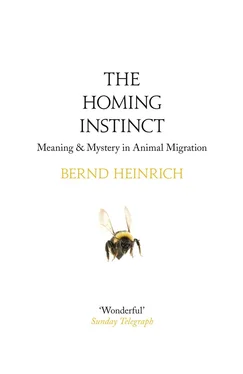1 ...6 7 8 10 11 12 ...19 The experiment we wanted to do was in doubt. This was serious. Two hundred thousand Euros had already been spent on this study, and the boss was intolerant of negligence. Luckily, bees from hives used previously for another experiment were still coming into the field to search for feeders. He could let some of those bees find the feeders and then train them to come back to specific locations.
For our experiment we needed to establish two feeding stations, A and B, separated by about three hundred meters. Certain bees were already keyed into the routine. When I walked across the field, one bee started following me. It looked most extraordinary: it had a lot of blue and green color, not just the usual plain brown honeybee attire. As soon as Menzel’s helper and I set up our feeder, this specific bee landed on it and immediately started to suck up the rich sugar solution. Now I could examine her more closely: the green was a plastic tag with the number 29 on it that had been glued to her thorax. The blue was a slash of paint that had been daubed onto her abdomen.
Within a few minutes an assembly of several differently color-coded bees was lined up around the edge of the syrup dish. All were sucking up syrup. Some had green on the thorax, some had blue, and still others had yellow tags on their thoraxes, with additional daubs of white, blue, or yellow paint on their abdomens. Uwe Greggers and the unfortunate helper immediately started logging a list of the bees that had shown up in a notebook.
Each bee tanked up quickly, flew off directly toward her hive at the other end of the field, and then came right back to take a next load. Newly recruited (unmarked) individuals were also coming every minute to our site A. At the second feeder (site B) there was a similar flurry of activity, except it involved different individuals.
Menzel then instructed us to move our food station A one hundred meters closer to the second one, B. Bee numbers 29 and 30 green, both with blue tails, number 2 yellow with white tail, and number 39 green with red tail (who had all been present at A) then almost immediately started showing up at B, the new location. When crowds of bees had done the same, we removed one station and put the remaining one into the middle, between the two original sites. Next we moved our feeder to site B. Most of the bees, such as 30 green with blue and 39 green with red, who had been at the previous site, showed up. That is, we had trained bees who had been at one site to come to the second site, so we knew they now knew two sites and could potentially use either as a reference site to return home.
For the planned experiment it was important that the bees forget the intermediate sites that had been instrumental in getting them to go to the two widely separated sites. So, for the rest of the day, we alternately fed the bees, first at site A, then at site B, and monitored which individuals were showing up at both sites (most of the individuals continued to forage at either one or the other site).
We were now, near the end of the day, finally ready to move from training to trials. The experimental plan was to select one of the bees who knew both sites. This bee would, after feeding at one site and getting ready to leave, be captured in a dark box and thus “blindfolded” and then brought to a third feeding site where she had never been before. Here she would be released after being equipped with a radar-tracking transponder. We presumed that she would do at least one of three things: she might recognize where she was and fly straight home; she might instead fly off in her original (now wrong) direction; or she might immediately know that she was at an unknown location and search until she found one of her two feeding sites and from there take a direct beeline home. Knowing her exact flight path would allow us to distinguish among the alternatives, which would be essential to ultimately decoding her homing mechanism. Setting up this experiment had taken a long time, but I would now, possibly, be treated to an exciting demonstration of bee homing, one I could never have imagined possible.
Menzel picked up his walkie-talkie to call the radar station: “Mike, we’re now going to put a transponder on a bee — are you ready?” Mike had spent some years in the army where he was trained on radar, and he was now working part-time while getting a university degree in computer technology. He replied yes, he was ready. Menzel then took me to feeding station A, where a whole lineup of bees was coming and going.
“Which one do you want?” Menzel asked me. I wanted a bee that I had gotten to know over the course of the day, so I chose 39 green with red-tipped abdomen. We waited for her to arrive and let her feed for a while. As planned, Menzel then held a glass vial over her while she was distracted sucking up syrup. When she was full, she walked up into the vial, and Menzel corked it shut and darkened it by wrapping his hand around it. We then took her to a site distant from both feeders, a place where she had not previously fed and from where we would now release her.
The vial holding “39 green” had a plunger at the bottom with a wide-mesh screen at the top. Menzel gently pushed the plunger in and forced the bee up against the screen, held her there, and picked up a tiny transponder (a wire holding a diode with a sticky pad at one end). With fine tweezers, he deftly removed the protective paper from the sticky pad and glued the transponder onto the top of the bee’s thorax. “Ready?” he radioed Mike.
“OK.”
Menzel removed the plunger and held the vial with the open end up, for the bee to crawl up. She hesitated at the lip of the glass, groomed her antennae, and then lifted off. She showed no strain in flight. (The transponder’s weight is twenty milligrams, and a bee can fly with double her body weight, carrying a hundred-milligram load of nectar in her honey stomach plus two pollen packets on her hind legs.) However, she flew only two or three meters before dropping down into the grass, stopping to preen herself some more. But a couple of minutes later, she finally took off again. Mike, who was now monitoring her flight, radioed us. At intervals we heard: “She is heading south-north-east-north-west-south.” Then, finally, Mike continued: “ Now her path is straightening out — now she is heading directly for her hive!”
She had suddenly oriented correctly. This was the crucial point: she had apparently recognized something that had “placed her on the map,” so that she then “knew” in what direction to fly to reach home. Assuming she had taken a path she had never taken before, did her successful homing suggest a “map sense”?
I ran over to the radar tent where Mike showed me the radar screen and the dots where the three-second successive readings traced the bee’s path. A computer screen, where software had converted the time and directions of the bee’s flight path into different-colored images for easy reading, showed that the bee’s original flight direction was toward where the hive would have been had we not moved her from her feeding spot. In other words, she acted as though she didn’t know where she was when we released her. As expected, however, after she reached the area where her hive would have been, she flew loops in several directions. Then, after she had flown ever-farther away from both her real and “would-have-been” hive locations, she suddenly seemed to orient and flew directly toward the hive. Amazingly, it was along a route that had not been her normal foraging route from her two feeding sites. Had she perhaps seen a blue or a yellow tent and, having learned their relationship to each other during previous orientation flights, transposed that information to fix her new location? Only more bees could tell.
Читать дальше












